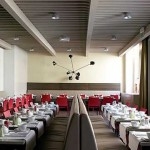HOTEL RESTAURANT DESIGN
|
Excellence in hotel restaurant design is more important than ever before for hoteliers. The quality of the F&B experience is fast-becoming a reputation maker for hotel businesses – and with more outlets entering the market, increased competition around hotel restaurant design has emerged. We speak to Janine Ramsay, Senior Interior Designer at Restaurant Design Associates (RDA), and ask exactly how important hotel restaurant design is in the current marketplace. Hotel-industry.co.uk: What makes a good hotel restaurant design? We believe that a successful design demonstrates that every element has been considered, from optimising space and operational flow through to design originality and practicality. The proof of a good design is in the ability of the interior to have a distinctive atmosphere that is welcoming and relaxing, and is subtle enough no to distract from the food itself. Hotel-industry.co.uk: Is designing for a hotel restaurant different from designing a standalone restaurant? Likewise it is very important that the standards and attention to detail throughout the hotel are continued within the restaurant interior, so that the elements merge – the restaurant should be synonymous with the hotel itself. Hotel-industry.co.uk: How important is restaurant design in the dining experience? All of these things, once combined create the dining experience, and I think that each of these elements should have the same degree of emphasis. If one element was to be weaker than the rest, then the whole dining experience will be affected. Hotel-industry.co.uk: What is the average life span of a restaurant design? Clients invest a substantial amount of money in the design and fit out of their restaurants. Therefore in many instances where it would be advantageous to incorporate all the elements of the current design trends or furniture styles, we as designers need to consider longevity. For example, one way of doing this is by specifying classical quality furniture, which in future years can be updated by simply replacing the upholstery. Another tip is to install a solid wood floor, which can either be left to age or stripped back and re-stained. Hotel-industry.co.uk: How did you approach and deliver Aloft? For us the key was to ensure that we created a design that was well considered, not only from a functional and practical point of view, but also in terms of being unique and inspiring. We carefully considered every element, from the general interior design style and use of materials, the furniture, the customer perception, how orders would be placed and also the back of house areas, such as how deliveries would be made, how the flow of the cookline would work. These all influenced the design process, and were key to making this project a success, along with our commercial understanding of project delivery. Hotel-industry.co.uk: Are you noticing any emerging trends in hotel restaurant design? Where do you think trends are heading in this sector. Many years ago the hotel restaurant offered a warm fine dining experience, where soft interior furnishings, white linen tablecloths, carpets and wallpaper provided the backdrop for the formal dinner. Over the past few years have been asked more often to create less formal designs, whereby the barriers between the kitchen and public areas have been removed. Central production and cooking areas are been brought front of house, to ensure that the customer can experience the theatre of a live kitchen. As a result, interiors have become much simpler and informal, where the use of wooden floors, real wood unclothed tables, quality pieces of furniture and ambient lighting combine to create a warm and relaxing ambience. Hotel-industry.co.uk: Do you think this is set to continue? Source: www.hotel-industry.co.uk HTEditor |






